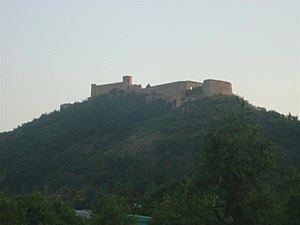 | ||
Similar Shankaracharya Temple, Shalimar Bagh - Srinagar, Pari Mahal, Dal Lake, Chashme Shahi | ||
Hari Parbat, or Koh-e-Maran, is a hill overlooking Srinagar, the largest city and summer capital of Jammu and Kashmir. It is the site of the Durrani Fort and has a notable religious dimension for the Hindus, Muslim and Sikhs alike, hosting a famous Hindu temple, two shrines of locally venerated Muslim saints and a Sikh gurdwara.
Contents
- Map of Hari Parbat Srinagar 190003
- Durrani Fort
- Sharika temple
- Muslim shrines
- Gurdwara Chatti Patshahi
- Legends
- References
Map of Hari Parbat, Srinagar 190003
Durrani Fort
The first fortifications on the site were constructed by the Mughal emperor Akbar in 1590 who built an outer wall for the fort as part of his plans for a new capital called Nager Nagor. The project, however, was never completed. The present fort was built in 1808 under the reign of Shuja Shah Durrani.
Sharika temple
The hill is considered sacred by the Kashmiri Pandits and hosts a temple of Shakti, or Goddess, which is located in the middle part of the western slope of the hill. Shakti is worshipped there under the name Jagadamba Sharika Bhagawati (or simply Sharika) and depicted as having 18 arms and sitting in Shri Chakra, an emblem of cosmic energy pervading the universe.
The hill is also called Pradyumna Peeth.
On the day celebrated as Sharika's birthday, devotees make a sacrificial offering of taher-charvan to the goddess (taher - rice boiled with turmeric powder and mixed with oil and salt; charvan – cooked goat liver). This day is also called Har Navum.
Muslim shrines
The southern side of Hari Parbat features Makhdoom Sahib, the shrine of Hamza Makhdoom, a 16th-century Kashmiri Sufi saint locally known as Hazrat Sultan and Sultan-ul-Arifeen.
Another shrine on the hill's southern slope is dedicated to Shah Badakhshi, a 17th-century Sufi saint.
Gurdwara Chatti Patshahi
Gurdwara Chatti Patshahi at Kathi Darwaja, Rainwari, Srinagar is one of the most important Sikh gurdwaras in Kashmir. It is believed that Guru Har Gobind, the sixth Sikh guru, travelled through Kashmir, stopping to preach occasionally and stayed there for few days.
Legends
Legend has it that Kashmir was a big lake called "Satisar" inhabited by a cannibalistic demon called Jalodbhava ("Water Demon") who tortured and devoured Nagas (the local inhabitants). The inhabitants approached Nilaga for help who approached his father, Kashyap, a great sage and grandson of Brahma. He did a long penance to rescue people from tyranny of cannibalism. He was blessed and was able to cut the mountain Near Baramulla. The lake was drained and the demon was killed by divinely cast pebble which today stands as "Hari Parbat".
Another version of the myth says that two demons, Chand and Mund, lived in the Kashmir Valley. Chand hid in the water near the present location of Hari Parbat and Mund somewhere above the present Dal Gate, and both terrorized the people of the Valley. The gods invoked Shakti who assumed the form of a hari (myna) and flew to Sumer, picked up a pebble in her beak and threw it on Chand. The pebble grew into a mountain, crushed the demon and was later named Hari Parbat ("the Myna Mountain").
